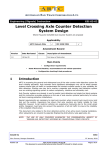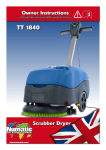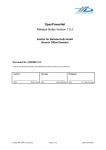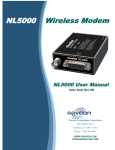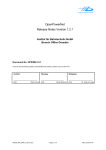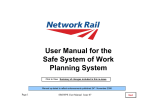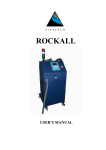Download Track Alert System - ARTC - Intranet
Transcript
Engineering Procedure- Form New Equipment & System Approval Proforma Form number: EGP2101F-01 NEW EQUIPMENT & SYSTEM APPROVAL PROFORMA Ref: 14/28485 Note: the prompts given below are only a guide to the information required for approval. Dependent on the type of equipment or system that requires approval delete any section that is not applicable or include additional information if necessary. Mandatory fields are marked with an asterisk (*). 1 Equipment or System to be approved * Track Alert System (TAS) 2 Originator * Name: 3 Sonia Whiteman Company: Imtram Pty Ltd Introduction * Designed and built in Melbourne Australia, the Track Alert System (TAS) is an automatic track warning system designed to provide early warning to track staff of vehicles entering the workzone via the track. It is designed to work in conjunction with your existing safe work practices as an additional tool, or layer of protection. The system can be set out to monitor trains entering the workzone approximately 2km from the workzone. It is also capable of operating in a single or bi-directional mode. When you have a bidirectional track that requires monitoring there will be 2 boundaries, otherwise there will be only one boundary. 4 Determination of Need * This technology is designed to assist in the prevention of near misses and fatalities to track crews when undertaking maintenance and construction activities. Despite the use of lookout protection, these occurrences are still being recorded. They include trackworkers and machinery working adjacent to operating lines as well as on working lines (eg for inspections). Extracts from TSV Report June 2012 A focus of TSV’s Rail Safety Compliance Program in 2011/2012 includes track side worker safety. The increase in near misses with track workers/equipment is of particular concern. These incidents regularly involved work being undertaken where only lookout protection (administrative control to treat risks) was in place. In some of these cases equipment was operated immediately adjacent to the track with the potential to foul the mainline. Protection arrangements on track are aimed at preventing workers being struck by approaching trains and to prevent entry of trains onto unsafe areas of track. Apart from the devastating loss of life or serious physical injuries sustained by those involved in such events, incidents and near misses involving track workers can result in significant trauma to train crews and co-workers involved. Many types of rail safety workers are involved in applying safeworking rules to manage risks working around the track. They include track protection coordinators/supervisors, hand signallers/ flagmen, maintenance workers, network controllers, signallers and train drivers. Incidents can occur when rules and procedures are not followed, or when other factors combine to result in a hazardous situation. A review of safeworking incident reports provided to TSV from accredited operators during 2011 identified a number of actions and circumstances. The following examples of errors and violations occurred during work site protection tasks: • a hand signaller observed placing protection on track while a train was approaching • a flagman positioned too close to the worksite providing insufficient warning time for the train crew to respond • a flagman positioned in a way that caused confusion as to which track the warning applied • no audible track warning (ATW) devices in place on approach to a worksite • ATWs placed on wrong track • failure to obtain appropriate authorisation for electrical works • work group observed without a lookout in place • heavy machinery operating close to a running line without protection in place • workers placed where no position of safety was available (e.g. on a bridge) • failure of track workers to move to a position of safety and give the ‘all clear’ hand signal to approaching train • a flagman away from his post (e.g. observed to be in a car) and/or flags left unattended on or next to the track • a flagman giving an inappropriate hand signal (e.g. showing the ‘all clear’ hand signal when workers were still on track) • multiple work groups within an absolute occupation without individual permits to foul • workers observed walking underneath overhead electrical wiring while it was being maintained • workers observed standing on an adjacent, unprotected line • ATWs left in place following work and removal of the flagman • a supervisor failing to inform a flagman of works being completed and inner flagman protection having been removed. While these actions involve some form of error or violation by individuals, it is also important to think systematically about what might have led to the occurrence. Such actions are influenced by the local workplace environment and factors in the organisational system. Rail operators and infrastructure managers experiencing such events need to consider what measures can be applied to minimise the likelihood of these behaviours and accidents arising as a Version 1.0 Date of last revision: 02 Sep 11 This document is uncontrolled when printed. See ARTC Intranet for latest version. Page 1 of 5 Engineering Procedure- Form New Equipment & System Approval Proforma Form number: EGP2101F-01 consequence. Rail operators are required to eliminate or reduce risks to safety so far as is reasonably practicable. This includes the risks and hazards associated with work on the track. Operators should review their risk registers regularly and ensure controls are appropriate and implemented correctly. This includes keeping abreast of new technologies and methods of work and adopting these where they are reasonably practicable. Potential contributing factors listed are knowledge and experience, fatigue, time pressure, distraction, noise, poor visibility, social norms and lack of coordination between different groups. The TAS is designed as a tool for track workers and lookouts. It adds an additional layer of protection by providing longer warning times as well as audible and visual alarms. These alarms can also be carried in vehicles on the worksite so that all at risk are warned of track vehicles and rolling stock entering the danger zone. It is aimed to provide further warning to those at risk to vacate the track in time. It will assist in reducing the risks associated with: 5 - Fatigue - Distraction - Poor visibility - Lack of co-ordination between groups Significant Change or Not (as determined by the Manager Standards) * This change in equipment or system is assessed as SIGNIFICANT 6 Review Panel (as determined by the Manager Standards) * • 7 John Furness - Manager Standards • Doug Adams – Systems Performance Manager • Greg Watson – National Rules Manager • David Ogucha – Track and Civil Standards Engineer Safety See point 4 above 8 Performance and Suitability See point 4 above. The system is designed in accordance with Australian electrical and Radio Frequency standards and is tested to achieve its IP rating. In general, the system operates as described in the following example: 1. 2. 3. A train or Work Vehicle passes the train detectors at Boundary 1, they detect the train or work vehicle and the repeater Unit sends a signal to the worksite. At the worksite the repeater unit then receives this signal and sets off the Personal Units, the Lookout Units and the Worksite Units. They will chirp and flash and continue to do so until the vehicle has finished passing the train detectors at the Boundary. As the vehicle leaves the zone and passes the detectors at Boundary 2, no alarm will sound. The Lookout unit has an additional feature in that it can set off the worksite warning units as well, independent of the train detectors. This way, the warning units can be used for any other danger the lookout sees on site. The system has been specially designed with the following features: • Quick and easy set-up (can be done under traffic) • Works as a Bi-direction or Single Direction unit Version 1.0 Date of last revision: 02 Sep 11 This document is uncontrolled when printed. See ARTC Intranet for latest version. Page 2 of 5 Engineering Procedure- Form New Equipment & System Approval Proforma Form number: EGP2101F-01 • Can provide a warning distance of up to 2km from the worksite • Detects Trains and Hi-rails, but not rain and animals • In built battery and signal strength indicators • Failsafe system warns if system is not operational At the designated boundaries, the Train Detector slips quickly and easily under the rail. No adjustment of sensors is required for the system to operate At the boundary, the repeater station is also quick and easy to set-up. The system comes in 3 robust cases. One for each Boundary and one for the worksite. At the worksite a receiver and alarm units work together to warn of oncoming traffic. The Worksite receiver receives the warning from the Boundary and sets off the worksite alarms. These alarms come in three different configurations: 1.The lookout unit includes an additional feature so that the Lookout can set-off the alarm for other reasons as well. 2. The Personal Warning Unit is small and compact. 3. The Site Warning Unit sits on a tripod for visibility and audibility. Please see attachments which include the following: Overview of the system Video of the installation Version 1.0 Date of last revision: 02 Sep 11 This document is uncontrolled when printed. See ARTC Intranet for latest version. Page 3 of 5 Engineering Procedure- Form New Equipment & System Approval Proforma Form number: EGP2101F-01 - (i) User Manual Use in other rail networks The system has been developed over a number of years with much testing at Aurizon. Melbourne Metro Trains have also provided significant track time for testing because of their interest in the system Please see attached letters from potential users of the system. Greg Watson at ARTC has lent his support for this project to proceed. (ii) Use in the ARTC network None so far (iii) Issues arising from usage of the equipment/system The system uses both short and long range Radios to transmit warnings. The system has transceivers within the 900 MHz ISM band and in the 450 licensed band. The system is used with the 450 MHz radios as a link extender between groups of 900 MHz ISM band units where propagation is otherwise insufficient. We have been testing on 455.525 MHz using a Raveon RV-M7-UC radio (450-470 synthesised, 12.5 kHz channel spacing, 4800 bps) with a 2 dBi Omni antenna at one end and a 11 dBi Yagi at the other. Transmit power is turned down to around 2.75 W. The owner of the equipment will require a licence to operate in the long range band. Please note that Aurizon have already done this for the system in anticipation of a network wide rollout. (iv) Changes required to infrastructure or systems for use of the equipment NA 9 Reliability The system has been tested around overhead lines and around signalling, no issues have arisen. The train detectors are mounted on the track by way of a polycarbonate plate, thus are insulated from the track. The system must be charged prior to use. As the system is battery operated, battery performance will deteriorate over time. At this stage they will need to be replaced by the manufacturer. The system also has a battery and signal strength indicator to assist users when using it. So far the system has been tested in Northern Queensland and Melbourne Metro. It has also been demonstrated to Rio Tinto in WA. As a result of this the system has been configured to these track types and rolling stock configurations (including hi-rail trucks and utes). Although this testing should now have identified most types of vehicles and track in use, we still recommend a commissioning phase that includes data collection and testing to ensure the track types and rollingstock types are detected by the technology. The system has been developed with a simple diagnostic tool so that our engineers can quickly and easily amend the program for any anomalies that may come up during this phase (generally 1 – 2 weeks). As the system is quick and easy to install we recommend a short half day overview with track teams and a 1-2 days with safety teams. This time would be mostly on track with traffic coming over the equipment, thus demonstrating various signals and problems etc they may encounter. The system is also able to be connected to a mobile device to transmit data to Melbourne for trouble shooting should this be necessary. 10 Maintainability The system requires charging prior to use. Because it includes rechargeable batteries, their charge time will over time deteriorate. Should this be the case, Imtram Pty Ltd, based in Melbourne are able to perform any maintenance. 11 Approval * Track Alert System “TAS”. Parts to be supplied are as follows: Each kit has 3 boxes containing the following: • • 2 Boundary systems. Each Boundary consists of: o 2 x train detector o 1 x repeater with antenna and tripod o Hard cases and chargers Worksite system consisting of Version 1.0 o 1 x receiver with antenna and tripod o 2 x site warning unit o 3 x personal warning units o 1 x Lookout Unit o Hard cases and chargers Date of last revision: 02 Sep 11 This document is uncontrolled when printed. See ARTC Intranet for latest version. Page 4 of 5 Engineering Procedure- Form New Equipment & System Approval Proforma Form number: EGP2101F-01 12 Conditions of Approval * This approval is for the purposes of a trial and the following conditions must be adhered to 1. Installation and operation must be undertaken by fully trained and competent personnel with proof of competence provided to ARTC before start of trial. 2. Records of maintenance need to be provided and kept on site at all times. 3. Existing ARTC network safe working rules must be applied. In exception to the Note within TA20 ARTC Code of Practice for the Victorian Main Line Network, Section 15 Infrastructure Works Rule 15 Actions by Employees on the Approach of a Train, which states ‘Where an authorised apparatus is provided for the purpose of giving warning it will not be necessary to employ lookout(s)’, a Lookout must be proved where this unit is trialled. In exception to 3.11.20 Train Running Information (TRI) – Advice and warning of approaching trains item (f) within the Code of Practice for the Defined Interstate Rail Network a Lookout must be provided where this unit is trialled. 4. A test plan including criterion for judging a successful trial must be prepared and accepted by ARTC Standards Manager before the trial. The test plan is to include a shift test log to be completed by the Protection Officer at the end of each shift during the trial period. The shift test logs are to be utilised in compiling the end-of-trial report. 5. Site and task specific PPE to be worn at all times. 6. A risk assessment is to be conducted prior to the commencement of the trial. 7. Appropriate training of Protection Officers and briefings for work groups is to be undertaken in setting up the equipment, recognition of all warnings provided by the system (including audible system failure warnings), pack-up of the system after use, and routine maintenance (including regular battery charging). 8. The geographic location of trial sites shall be stated in the test plan, and utilisation of the trial system shall be limited to those sites. 9. Safe Notice to be issued when system is used at a NSW site, or Train Notice when used at a VIC or SA site. 13 Does the Originator accept the additional Conditions of Approval as set by the Review Panel: 14 Sign off Yes No N/A ARTC office use only Review Panel: John Furness On File Date: 7/08/2014 Doug Adams On File Date: 5/08/2014 Greg Watson On File Date: 5/08/2014 David Ogucha On File Date: 5/08/2014 Approval: Operations Safety & Environment Review Group Version 1.0 11 August 2014 Date of last revision: 02 Sep 11 This document is uncontrolled when printed. See ARTC Intranet for latest version. Page 5 of 5





